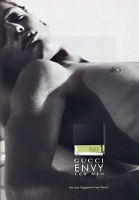
Mainstream men’s colognes — a wearying bunch of scents that more often than not smell of “cold” citrus (harsh, metallic, faux citrus) floating on a sea of “marine” notes or buffeted by ozonic winds. This type of fragrance (apparently beloved by market research guinea pigs) rules the mainstream male perfume world and no matter how many interesting ingredients are mentioned in ad copy — May rose, myrrh, olive wood, hay, nasturtium, etc. — chances are, when you sniff a new men’s fragrance, you will detect only citrus, ozone or marine notes, a touch of wood, and a squirt of tepid musk. Boring, boring, boring.
When Gucci released Pour Homme in 2003, I was relieved to read its list of notes: white pepper, pink bay, ginger, papyrus wood, orris rhizome, vetiver, amber, white olibanum and leather — no citrus, no evocations of the shore or high altitudes…


